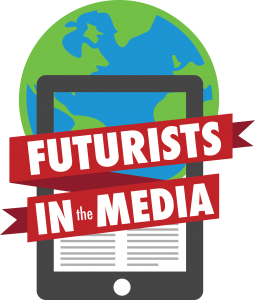The Houston Foresight program initiated a project to track, collect and analyze mentions of futurists in the media back in January 2015. The goal is to gather evidence for how futurists are being talked about in the media. The initial idea for this project was suggested by APF member Natalie Ambrose in 2008.* We have experimented with different means for doing this — including devising search bot — and will continue to do so. For now, a simple analysis of daily “Google Alerts” has provided a consistently useful dataset on mentions of futurists in the media.
 We are following the basic steps of the scanning process we teach in the program:
We are following the basic steps of the scanning process we teach in the program:
- Finding: We are continuing to use Google Alerts, as we explore other avenues.
- Collecting: We are using a Diigo social bookmarking site (we are keeping it private…at least for now); we used one of these with excellent results in ourStudent Needs 2025+ project. The tagging system:
- Name (of “futurist”)
- Tone of coverage: Positive – negative – neutral
- Note if APF member
- Note Whether organizational, consulting, academic, “accidental” (explained below)
- Topic of piece
- Article-specific tags
- Analyzing: We experimented with weekly, monthly, and quarterly reporting of results on our blog; we also want to write up the result in one of the foresight journals.
A few interesting observations so far.
- Ray Kurzweil is the futurist appearing most frequently in the media. But right behind him is speaker Jack Uldrich, who appears to have a very well-refined apparatus for promoting his upcoming speeches (such that we gave him his own category of Uldrich PR). There is no one else even close.
- We came up with the term “accidental” futurist for those who were dubbed futurists by the reporter/media outlet, but did not refer to themselves as futurists. There seems to be a small trend to describing one who talks about the future as a futurist.
- While no one is mentioned on the scale of Kurzweil and Uldrich, Sheryl Connelly of Fordand Brian David Johnson, who just left Intel, come up fairly frequently. A reasonable hypothesis is that in-house futurists seem to be more credible to the media (Kurzweil is frequently cited as Google’s in-house futurist).
- The rate of mentions of what we might loosely call professional or at least working futurists (including “pop” futurists) is close to, but less than, one per day. There are more mentions of futurists in terms of the art movement, the band, and other assorted odds and ends.
- And now for the challenging news. There are very, very few mentions of futurists who are members of APF. On the one hand, it makes sense that futurists who are going about their work with clients are not popping up on the media radar. On the other hand, it would not be too difficult to fill the void, should we choose to. For me, paying more attention to promoting the good work professional futurists are doing would be a sensible component of an overall long-term strategy of awareness-raising and spreading foresight work. — Andy Hines

Hi Andy, Good to track this. I tried a google alert for “futurist” and it appears to favor links where the word futurist is in the title. That happens more often when the futurist is a name brand like Ray Kurzweil, he is identified in the title “futurist Kurzweil”. it’s high on the google search list for “futurist” because of that and as well as number of searches for him, not futurist.
When I search particular APF members, I get many more hits in the news. Thomas Frey 30+, Glen Hiemstra 30+, JIm Dator 8, and for member firms, far more – The Futures Company, IFTF, Foresight Alliance. I stopped there. APF members get a lot more media attention than this project identifies. Is it tracking what we need to know?
Tracking “futurist” seems give a flat landscape, not futurists mentioned in the media, which would be useful indeed. It might just be too hard to monitor.